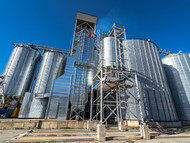How Exactly Does a Feed Grain Elevator Work?
Published by The Grain Handling Direct Team on Aug 29th 2022
As a farmer, you’re probably very familiar with grain elevators. Those gigantic structures have become a second home to you after all these years! However, you may not know the particulars of how grain elevators work. For curious farmers as well as the general public, let’s take a look at how exactly feed grain elevators work.
What Is a Grain Elevator?
As a farmer, a grain elevator is your grain storage location. For the public, you can think of grain elevators as one of the many checkpoints along grain’s journey from the farm to your table. Most of the time, grain elevators are located on main waterways, highways, and railways. This is so they’re easy to access for farmers who need easy transportation options for food producers.
Bringing the Grain
The first step in the process is the farmer’s responsibility. For grain elevators to do their job, a farmer needs to harvest sorghum (used for livestock feed and ethanol production), grain, or corn and bring their harvest to a grain elevator.
Sample and Weight
Once the grain has reached the elevator, the truck needs to be weighed and the grain sampled. The sample determine the grain’s quality and tells farmers if the grain is too wet, too dry, or just right. If the grain is too wet, it must be dried before entering the grain elevator. The excess moisture could cause mold growth in the elevator.
Once the grain has storage approval, it is unloaded and the truck is weighed again. When you subtract the initial weight from the new weight, you can see how much grain the farmer brought in.
The Mechanism
A mechanism known as a grain leg transports the grain from the ground to the top of the grain elevator through a series of rectangular buckets. The buckets travel up, depositing grain, and come back down to collect more, beginning their journey again.
Now that you know how exactly feed grain elevators work, we hope you have a better understanding of the incredible engineering that goes into these structures.

